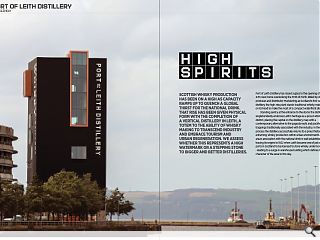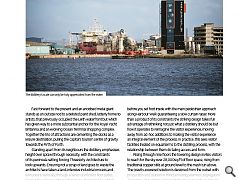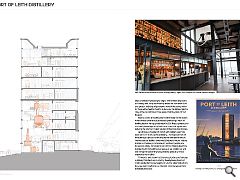Port of Leith Distillery: High Spirits
23 Jan 2024
Scottish whisky production has been on a high as capacity ramps up to quench a global thirst for the national drink. That rise has been given physical form with the completion of a vertical distillery in Leith, a totem to the ability of whisky-making to transcend industry and embrace tourism and urban regeneration. We assess whether this represents a high watermark or a stepping stone to bigger and better distilleries.
Port of Leith Distillery has raised a glass to the opening of its £7m new home overlooking the Firth of Forth. Billed by drinks producer and distributor Muckle Brig as Scotland’s first vertical distillery the high-rise plant stands traditional whisky making on its head to make the most of a compact waterfront site. Standing sentry at the entrance to the docks the distillery singlehandedly endorses Leith’s heritage as a proud whisky district, placing the capital on the distillery map with a contemporary alternative to the pagoda roofs and packhorse trappings traditionally associated with the industry. In the process the distillery successfully returns to a proud history of entwining whisky production within urban environments.
The area’s association with the national drink is well established, tracing its origins to 1822 when Leith became one of just six ports in Scotland to be licensed to store whisky under bond - leading to a surge in warehouse building which defines the character of the area to this day. Fast forward to the present and an anodised metal giant stands as an outsize nod to a delisted paint shed, latterly home to artists, that previously occupied the Leith waterfront but which has given way to a more substantial anchor for the Royal Yacht Britannia and an evolving Ocean Terminal shopping complex. Together the trio of attractions are cementing the docks as a leisure destination, pulling the capital’s tourism centre of gravity towards the Firth of Forth. Standing apart from its neighbours the distillery emphasises height over sprawl through necessity, with the constraints of its peninsula setting forcing Threesixty Architecture to look upwards. Ensuring not a scrap of land goes to waste the architects have taken a land-intensive industrial process and extruded it vertically through a series of efficient floorplates, leaving the precious ground floor to be dominated by a brick backpack that houses the main public spaces including an entrance and shop, with tasting rooms and laboratories above. This frees up the main tower for core distillery processes and segregated vertical access.
Emphasising a sense of playfulness inherent in rising high, particularly on a shoreline location which permits wide views and a chance to catch shimmering reflections on water, the resulting 50m structure gives new meaning to the term unmissable, but is it well suited to the mechanics of distillation? The drama of the building is revealed in stages even before you set foot inside with the main pedestrian approach along Harbour Walk guaranteeing a slow curtain raiser. More than a product of its constraints the striking design takes full advantage of rethinking not just what a distillery should be but how it operates to reimagine the visitor experience, moving away from ad-hoc additions to making the visitor experience an integral element of the process. In practice, this sees visitor facilities treated on equal terms to the distilling process, with the relationship between them dictating access and form. Rising through nine floors the towering design invites visitors to reach for the sky over 28,000sq/ft of floor space, rising from traditional copper stills at ground level to the mash tun above.
The gravity-powered solution is designed from the outset with production and tourism in mind, ensuring seamless segregation of workers and visitors. Instead of flowing outwards, guests are ushered skyward as the distillation process is turned on its head with gravity powering the process as whisky and visitors alike flow from top to bottom. Lower levels house the distinctive copper stills maintaining connections with tradition but in a modern twist gravity-fed pipework frames views of the port. Open plan floorplates accommodate fermentation with pipework linking levels and encouraging visitors to crane their necks up as well as gaze out. A tale of two halves, the upper floors are defined by a large glazed slot doubling as a beacon for passing vessels and cruise ships as well as emphasising its height. Within these lofty rooms sit a tasting area, shop and a rooftop restaurant that serve up an ever-present backdrop of panoramic views of the activity within for those with a head for heights. In doing so the distillery tells the story of the rise and fall (and rise again) of whisky production in the port.
Built to convey an exciting and modern image for the Scotch whisky industry the vertical production plant brings the art of distilling back to the city, producing 400,000 litres of pure alcohol and taking advantage of the harbour as a heat sink, significantly reducing the volume of water required in the production process. Ian Stirling, co-founder of Port of Leith Distillery said: “We never set out to build a vertical distillery – the shape and size of the building is a product of the tiny site we were able to secure. We wedged our distillery tower into Edinburgh’s historic harbour to make our building as accessible as possible to people who, like us, love whisky. We’ve spent a lot of time thinking about how to make the Port of Leith tour as special as we possibly can and look forward to welcoming fans across the globe to a whisky experience like no other.”
Threesixty have shown that they are up to the job of building a distillery that stands up to scrutiny, thereby taking the art of whisky production to new heights. In turn, the nationwide whisky bonanza shows itself to be just the tonic for bringing new life to deindustrialised land.
|
|





